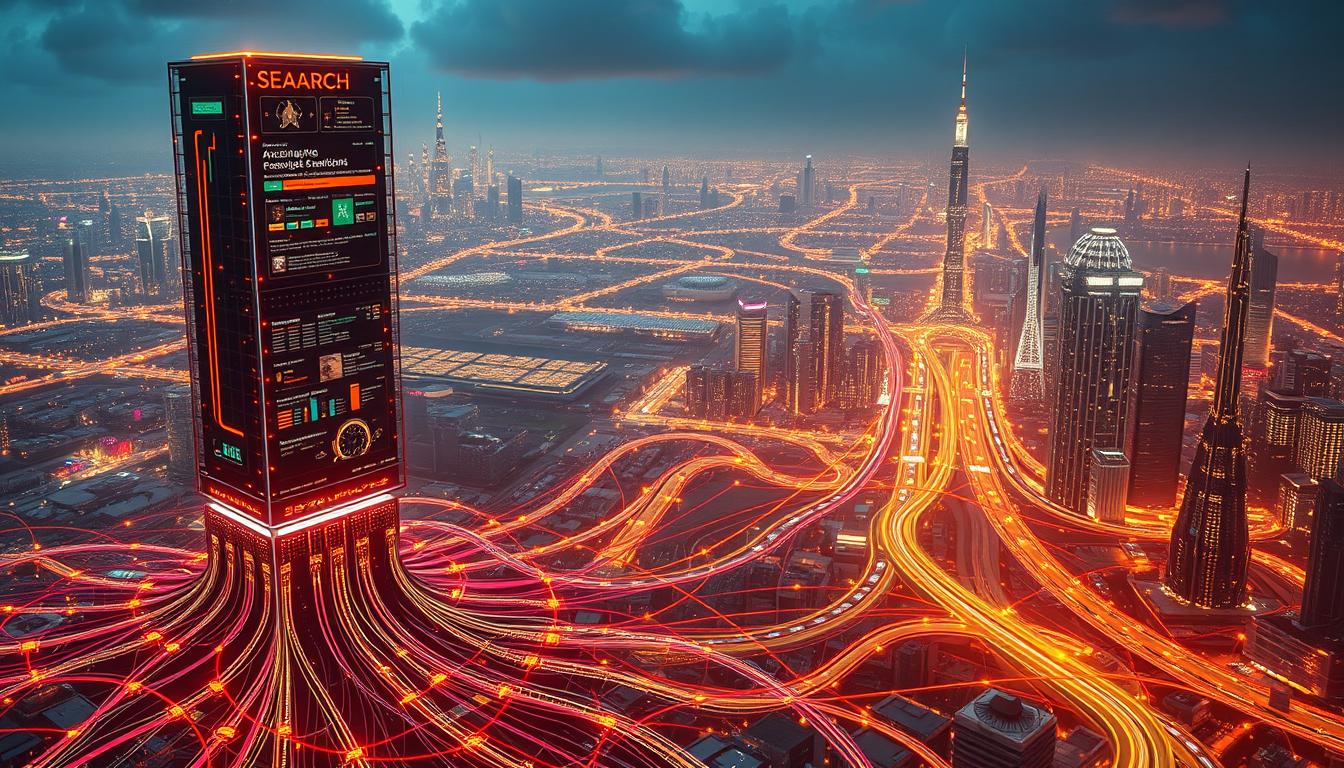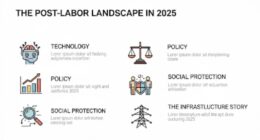Here’s a number that should make every business owner pay attention: AI search just captured 5.6% of US search traffic, according to market intelligence firm Datos. We’ll explore the market data, behavioral shifts, and strategic implications for businesses navigating this transformation. That might sound small, but when you realize this market share has doubled in just one year, it paints a completely different picture. We’re witnessing the beginning of the biggest shift in how people find information since Google first launched. ChatGPT alone is now handling 2.5 billion daily prompts – that’s nearly 20% of Google’s entire search volume. What does this explosive growth mean for your business, your website traffic, and the future of how we search for information? Could this be the moment that Google’s reign truly meets a challenger?
The Numbers Behind the Revolution
The numbers behind this revolution tell a story that goes far beyond simple percentages. What does 5.6% really mean when we’re talking about the entire search market? Here’s why this seemingly small number represents a transformation happening right under our noses. Every day, millions of Americans wake up and instead of typing their questions into Google, they open ChatGPT, Claude, or Perplexity. We’re looking at a fundamental shift where people choose to ask an AI assistant instead of scrolling through blue links.
But here’s where it gets interesting. This 5.6% market share didn’t happen gradually over five years. It doubled in just twelve months. Think about what doubling means in mathematical terms – we’re looking at exponential growth, not the slow, steady climb you’d expect from a new technology finding its place. When something doubles year over year, we’re witnessing the early stages of a hockey stick curve that could reshape entire industries.
The most fascinating part? Early adopters are already living in this AI-first world. Power users now spend 40% of their total browser time interacting with AI tools rather than traditional websites. Picture someone who used to spend eight hours a day online – they’re now dedicating more than three of those hours to AI conversations, problem-solving sessions, and AI-assisted research. These aren’t casual users experimenting with new toys. They’re professionals, researchers, and digital natives who’ve fundamentally changed how they access and process information. What makes these figures even more significant is that they don’t include Google’s own AI Overview searches, meaning the real shift away from traditional search could be much larger than what we’re measuring.
This growth pattern looks eerily familiar to anyone who lived through previous tech disruptions. Mobile web traffic went from barely measurable in 2007 to capturing 10% of all internet usage by 2012, then surpassed desktop entirely just four years later. The acceleration always happens faster than experts predict.
Market researchers are calling this shift a “sea change” comparable to Google’s original launch in the late 1990s. But there’s a crucial difference between what Google did and what AI search is doing now. Google revolutionized how we find information by organizing the web and pointing us toward destinations. You searched for “best Italian restaurants” and Google showed you ten blue links to restaurant websites, review sites, and local directories. AI search works completely differently – it solves problems directly within the conversation.
When you ask ChatGPT about Italian restaurants, it doesn’t send you anywhere. It analyzes your location, considers your preferences, weighs factors like price and atmosphere, and gives you personalized recommendations with explanations. It’s the difference between being handed a phone book and having a knowledgeable local friend give you advice. Traditional search was about finding destinations. AI search is about solving problems without ever leaving the conversation.
What does this mean for how we’ll discover and interact with information in the future? We’re watching the birth of a parallel information ecosystem. Instead of the internet being a vast library where we hunt for the right book, it’s becoming more like having a personal research assistant who can instantly synthesize information from thousands of sources and present exactly what we need. The implications go far beyond just changing which website gets our click.
Consider what happens when AI search reaches 15% market share, then 25%, then 50%. We’re not just talking about a new way to find the same information – we’re talking about fundamentally different expectations for how fast, how personalized, and how actionable our answers should be. Every business, content creator, and digital marketer built their strategies around the assumption that people would search, click, and browse. What happens when people stop clicking altogether?
We’re witnessing the early stages of the biggest change in how humans access information since search engines were invented. The 5.6% we’re seeing today represents millions of people who’ve already made the switch to a completely different way of thinking about questions and answers. But to truly understand the scale of this transformation, we need to look at the raw volume driving this change.
ChatGPT’s Billion-Query Explosion
ChatGPT processes 2.5 billion prompts every single day, according to figures OpenAI shared with Axios. Stop and think about that number for a moment. That’s 2,500,000,000 individual conversations, questions, and requests flowing through OpenAI’s servers in just 24 hours. This isn’t just impressive growth – it’s a fundamental shift in how humans seek information and solve problems.
Here’s where this gets really interesting. Google processes about 5 trillion searches annually, which breaks down to roughly 13.7 billion searches per day. ChatGPT’s 2.5 billion daily prompts means it has captured nearly 20% of Google’s entire search volume. Think about what that represents – one AI tool, launched less than two years ago, is now handling almost one-fifth of all the information requests that previously would have gone to the world’s dominant search engine. That’s not just market disruption. That’s a complete rewriting of the information landscape.
The growth trajectory tells an even more compelling story. Just seven months ago, ChatGPT was processing 1 billion daily prompts. The jump to 2.5 billion represents more than doubling in less than a year, suggesting we’re nowhere near a plateau. This isn’t the gradual adoption curve you see with most new technologies. We’re looking at explosive, exponential growth that shows no signs of slowing down. What happens when we hit 5 billion daily prompts? What about 10 billion?
But here’s what makes these numbers truly significant – we’re not talking about simple keyword searches. These 2.5 billion daily interactions represent complex, multi-turn conversations where people are working through problems, brainstorming ideas, analyzing data, and creating content. A typical ChatGPT session might involve 10 to 15 exchanges as someone refines their question, asks for clarification, or builds on previous responses. Each of those 2.5 billion prompts often represents the equivalent of multiple traditional Google searches rolled into one sophisticated problem-solving session.
This reveals a fundamental behavioral shift that goes far beyond just changing which website people visit. Instead of hunting for information, people are creating solutions through AI assistance. Picture someone planning a vacation. The old approach involved dozens of separate searches – flights to Paris, hotels in the 7th arrondissement, restaurants near the Louvre, weather in September, currency exchange rates. Now, that same person has one extended conversation with ChatGPT that covers all these topics and more, with personalized recommendations based on their specific preferences, budget, and travel style.
The usage patterns show just how different AI search really is. Traditional Google searches last seconds – you type, scan results, click, and move on. ChatGPT sessions stretch for minutes or even hours. People engage in iterative conversations, asking follow-up questions, requesting modifications, and building complex projects through back-and-forth dialogue. It’s the difference between looking something up and working through something together with an intelligent assistant.
AI search is creating new categories of human-computer interaction that simply didn’t exist before. People are using ChatGPT to debug code, write poetry, analyze complex data sets, create business plans, and solve mathematical problems – activities that go far beyond information retrieval into actual collaboration and creation. These aren’t searches in the traditional sense. They’re work sessions, creative partnerships, and problem-solving collaborations.
ChatGPT’s explosive growth from 1 billion to 2.5 billion daily prompts represents something much bigger than market share capture. We’re watching the birth of entirely new ways humans interact with information, solve problems, and augment their own thinking. The 20% of Google’s search volume that ChatGPT now handles isn’t just traffic that moved from one platform to another – it’s evidence of a completely different relationship between humans and digital intelligence. What will it look like when ChatGPT handles half of Google’s daily queries? The answer to that question is causing serious concern in some unexpected places.
The SEO Apocalypse or Evolution?
Marketing professionals are already calling this shift the “Generative Engine Optimization” pivot, scrambling to understand how to optimize content for AI responses rather than traditional search rankings. There’s genuine panic spreading through SEO agencies and digital marketing firms right now. Picture a $68 billion industry built entirely on one premise: getting websites to rank higher on Google so more people click through and visit those sites. Now imagine that fundamental business model facing complete disruption as people stop clicking altogether.
Traditional SEO worked because it solved a clear problem. Businesses needed traffic, and Google searches generated clicks that turned into customers. SEO experts became masters at understanding Google’s algorithm and optimizing content to push their clients’ websites higher in search results. The entire ecosystem depended on users clicking through to websites to get the information they needed. But AI search breaks this chain completely. When someone asks ChatGPT about the best project management software, they get detailed comparisons, pros and cons, and personalized recommendations without ever visiting a single software company’s website.
This disruption has created a scramble to adapt. Instead of optimizing content for Google’s algorithm, marketers are trying to figure out how to get their information included in AI training data and responses. But here’s the challenge: nobody really knows how this works yet. Google’s algorithm was mysterious but at least predictable in some ways. AI training and response generation involves such complex processes that even the companies building these systems can’t always explain why certain information gets included in responses while other content gets ignored.
Two competing theories are emerging about what happens next. The replacement theory suggests AI search will gradually kill traditional search the same way smartphones killed flip phones. According to this view, why would anyone go back to clicking through multiple websites when AI can synthesize all that information instantly? The additive theory argues that both systems will coexist because they serve different purposes. As marketing strategist Andrew Lipman points out, this mirrors the mobile internet boom – instead of replacing desktop usage, mobile created entirely new categories of digital behavior and business opportunities.
AI search might follow a similar pattern. When you need to navigate to your bank’s website to check your account balance, traditional search makes perfect sense. When you want to understand complex investment strategies or compare mortgage options, AI search provides more value. These tools serve different needs. Traditional search excels at destination-finding and navigation. AI search excels at problem-solving and productivity tasks that require synthesis and analysis.
What does this mean for the millions of businesses that built their entire digital presence around Google rankings? Content creators who spent years mastering SEO best practices now face uncertainty about whether their skills remain relevant. Website owners who invested heavily in search engine optimization wonder if their traffic will simply disappear as people stop clicking through from search results.
But there’s a potential silver lining that many people are missing. AI search might create new opportunities for businesses to engage with customers in more meaningful ways. Instead of competing for attention in a crowded list of search results, companies might find ways to provide value directly through AI interactions. Imagine customer service that anticipates problems before they happen, or product recommendations that truly understand individual needs and preferences. The businesses that figure out how to add value in an AI-first world might find themselves with significant competitive advantages.
Rather than an apocalypse, we’re watching the birth of a parallel digital ecosystem. Traditional search and AI search will likely coexist, but they’ll require completely different skills and strategies to master. The businesses that thrive in this new environment won’t be the ones that resist change, but the ones that learn to provide value in both ecosystems simultaneously.
If you’re an SEO professional, what’s your biggest concern right now? Let me know in the comments below. The transformation we’re witnessing goes far beyond just marketing tactics or search algorithms.
Conclusion
We’re looking at three fundamental shifts happening simultaneously. First, AI search has captured 5.6% of the market and doubled in just one year, showing exponential growth that mirrors every major tech disruption. Second, millions of people have fundamentally changed how they seek information, moving from clicking through websites to having conversations with AI assistants. Third, every business now faces a strategic imperative to understand how they’ll provide value when people stop visiting websites altogether.
What does this mean for you? Whether you’re a business owner, content creator, or simply someone who searches for information online, you need to start thinking about how you’ll adapt your strategies for this new landscape.
When AI search matches traditional search, how will your digital strategy evolve? Subscribe for deeper AI analysis and share your predictions about when AI search will hit 20% market share.









